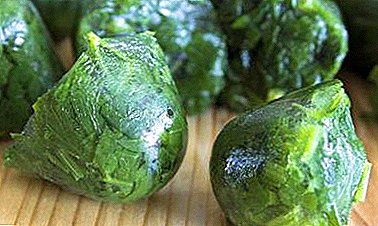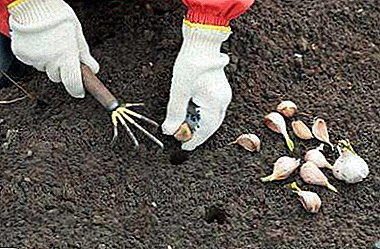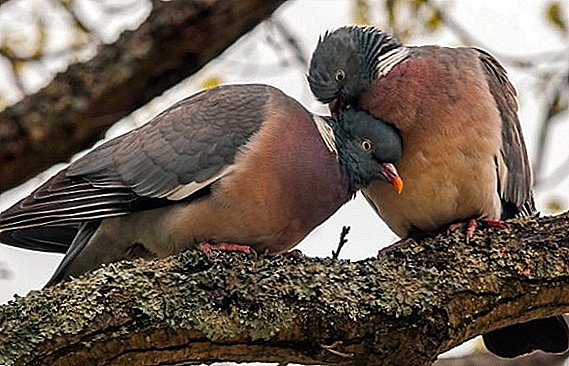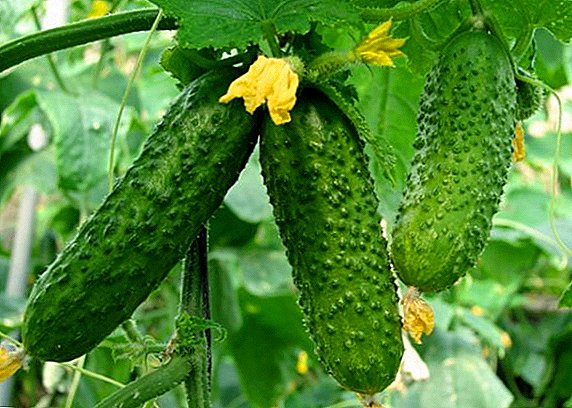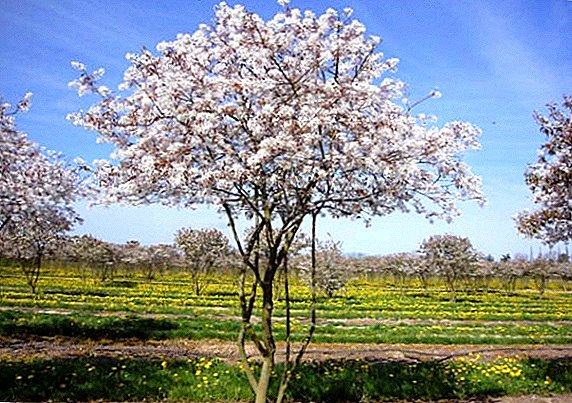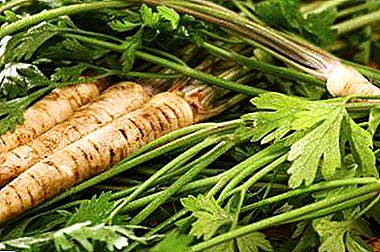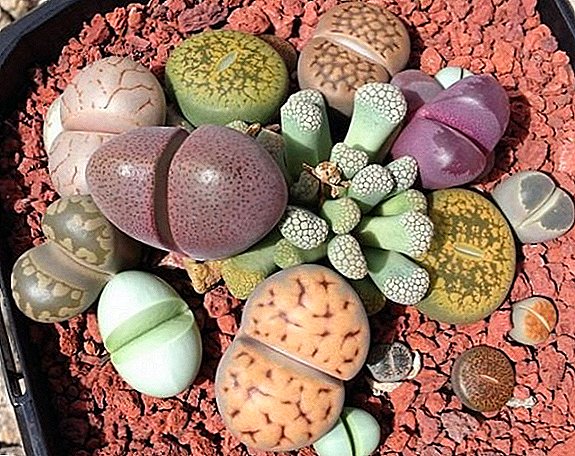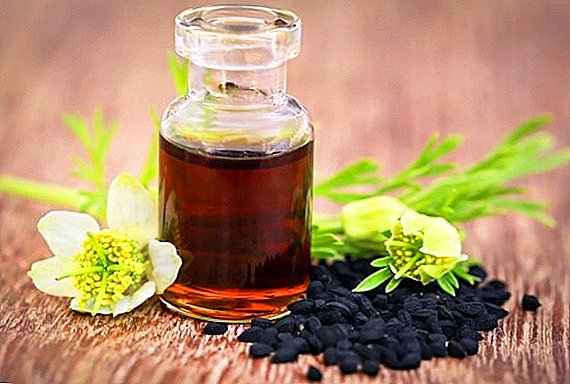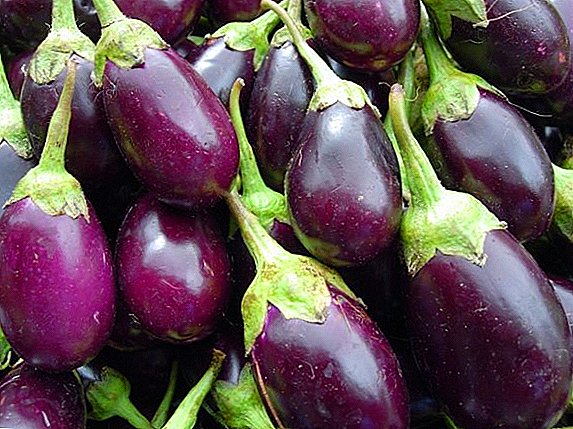 Eggplants (the national name is "blue") belong to the family of nightshade, as do potatoes, tomatoes, and sweet peppers. Planting this vegetable in open ground has its own characteristics.
Eggplants (the national name is "blue") belong to the family of nightshade, as do potatoes, tomatoes, and sweet peppers. Planting this vegetable in open ground has its own characteristics.
In the article we will look at conditions for growing eggplants, about which you need to know every gardener.
general description
Eggplant grass can reach from 40 to 150 cm in height. Large oval leaves, rough to the touch, can be green or purple. Purple flowers are single or gathered in brushes of 2-7 pieces, their diameter is 2.5-5 cm. The plant can produce up to 15 fruits.
The fruit itself is a large cylindrical berry pear-shaped or rounded, weighing up to 1 kg. Color can vary from violet to black. Decorative varieties are red, white. The surface of the eggplant is glossy, less often - matte. Gather the fruit slightly unripe, as fully ripe eggplants are rough and tasteless. Eggplant is a perennial plant by nature, but in temperate climates it is cultivated in a seedling manner as an annual. 
Did you know? The closest relatives of the little blue ones are tomatoes and potatoes, so eggplants are berries.
Selection of beds
Before you start growing eggplants in the open field, you should choose the right bed.
Lighting
Blue - heat-loving culture, so the place for their landing should be well lit and protected from strong winds. Eggplants do not tolerate heat: if the temperature under the scorching sun is more than 28 ° C, then you can forget about the long-awaited fruits.
The soil
The soil for blue should be fertile and retain moisture well.
Important! Eggplant roots must "breathe", so they cannot be planted in heavy clay soil.The best precursors for the culture are onions, cucumbers, legumes, cabbage. It is not recommended to plant in the soil where potatoes, tomatoes, sweet pepper grew. Eggplants can be planted in the same bed not earlier than in 3-4 years.

Peas, potatoes and beans are good neighbors of eggplants in the garden.
Landing technology
Before you grow eggplants in the open field, you need to start growing seedlings. First you need to choose the right planting material. If the seeds were harvested on their own, then you need to be sure that they were properly stored, and if they were bought, you need to look at the expiration date, which is always indicated on the package. Seeds retain their vitality for about 3-4 years, so those who have lain longer than this period, are unlikely to give a good result.
Timing
The beginning of February is considered to be the most suitable time for planting seeds. This is due to the fact that the bush will begin to bear fruit only in 3.5-4 months. During this time, he must grow out of a small seed and become a full-fledged plant.
How to prepare seeds
Seeds must be checked for germination: they are soaked in water for a day and then laid out on a soft, wet surface. Seeds that begin to roll in 2-3 days are suitable for planting. It is advisable to wash the seeds in hot water in order to wash off the essential oil from their surface, which prevents germination. You also need to sort, removing small and deformed. Disinfect seeds with a strong solution of potassium permanganate by lowering seeds into it for 15-20 minutes. Thanks to this method there will be no infections and you will get strong, healthy seedlings. You can also treat the seeds with a growth promoter (for example, with sodium humate, wood ash, or “Ideal” fertilizer). Prepared seeds can be planted.
Seeds also multiply: plumeria, blueberries, Indian onions, lisianthus, clivia, adenium, arugula, mountain ash (aronia), black-fruited, fennel and aglaonema.

Sowing seedlings
The soil must be fertile and loose. The best composition - humus, sod land and sand, but you can also use a ready-made substrate for vegetable seedlings, bought in a special store. Tanks should be shallow and wide. Seeds are sown to a depth of 5 mm, maintaining a distance of approximately 2 cm between them. Then they are immediately sprinkled with warm, boiled or boiled water. In the future, they need to be watered regularly, maintaining a constant soil moisture.
Care rules
Seed containers should be placed in the shade, where the air temperature is about 22-25 ° C. We must not forget that the plant is thermophilic, so the temperature should not be below 15 ° C, as this leads to a lag in development. After 10-14 days, green sprouts will start growing. Capacities need to be moved to a place with diffused light.
Important! You need to avoid getting bright sunlight on the sprouts, because they can destroy the plant.

Quality lighting throughout the daylight is necessary for seedlings. If the desired level of light is not available, you can use artificial lighting. Seedlings require regular fertilizing. For this, a tablespoon of calcium nitrate is diluted with 10 liters of water and, combined with irrigation, fertilize the seedlings approximately once a week.
For more successful germination of seeds, you can cover them with a film until the emergence of seedlings, thereby creating greenhouse conditions. A month later, the sprouts should already have the first leaves, they can be transplanted into separate containers. Two months later, grow small bushes, which should be transplanted into the ground.
Planting seedlings in open ground
Eggplant planted in open ground in early June. At this time, weather suitable for saplings is established. At the selected site, dig holes to the depth of the spade bayonet, keeping a distance of 40 cm, between rows — about 60 cm. Then pour a large volume of water into each well so that it is three-quarters full. Now you can plant seedlings in a well-soaked ground, slightly compacting the ground around each seedling. To grow quality eggplants, after planting seedlings in the ground you need to follow the rules for their care. 
Did you know? If you want to reduce your weight, then be sure to include in the diet meals with eggplant. They break down fats well and maintain the body's acid-base and salt balance.
Basic rules for watering plants
Eggplants are moody plants and require regular watering every 7-8 days. You can not use cold water from the well, as plants because of this can hurt and die. Water should stand in the sun for about a day - this temperature is optimal for irrigation. About 15 liters of water should be used for each square meter.
Soil care and hilling
During the season it is necessary to handle inter-row space several times - to loosen and weed. Loosening should be carried out at a distance of 10 cm from the eggplants themselves, so as not to damage the roots. The depth of soil loosening should first be about 10 cm, and then - 12 cm. With this method, the soil warms up well, and the air goes to the roots. Four times per season, eggplants need to be spudded a little, due to which side roots will develop.
Plant nutrition

Even if the land is fertile, it is still necessary to feed eggplants. Over the entire growing season, this is done three times.
- Two weeks after the seedlings are planted in the ground, they are fertilized. To do this, use a mullein infusion or bird droppings and a solution of mineral fertilizers (50 g of superphosphate and 30 g of urea diluted in 10 liters of water).
- Next time fertilized in a month. Use the same mineral fertilizers, doubled.
- The third time is fed at the beginning of the fruiting period. First, the bush is poured abundantly with clean water, and then the solution is poured (70 g of urea, 80 g of superphosphate and 20 g of potassium chloride are diluted in 10 liters of water). Fertilizer should be poured strictly at the root, so that it does not fall on the leaves and shoots.
Did you know? In the East, eggplant is called "longevity vegetable". Due to the large number of minerals useful for humans, the blue ones have a positive effect on the cardiovascular system. They are recommended to be used by elderly people.
Disease and pest treatment

The most important enemy of the blue is the Colorado potato beetle. Its larvae very quickly eat up all the green parts of the plant. It is also dangerous and spider mite, which multiplies due to the heat and low humidity. Bluefly pests include whitefly, polar bear, aphid. Slugs that gnaw shoots and leaves can also cause great harm. To protect the eggplant from parasites, the beds should be treated with insecticides, and sprinkled ashes and slaked lime in between rows. Colorado beetles and slugs need to be assembled by hand.
When to start and how to harvest
Approximately a month after the blue ones began to blossom, you can find the first ripe fruits. With the help of a garden pruner, they are cut together with the stem. Harvest must be collected before the onset of cold weather. If frosts begin, and some fruits are not yet ripe, you can carefully dig up the plant and transplant it into the greenhouse. Store ripe eggplants for a month in a cool place.
Grow eggplants - not an easy job but if you comply with all the norms of agricultural technology, then planting blue ones will not cause you any trouble and will please you with a good harvest.


